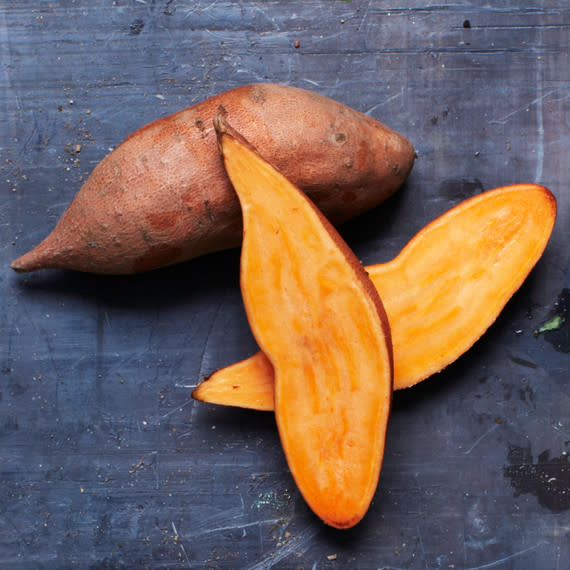Swapping White Potatoes for Sweet Potatoes Is One of the Easiest Diet Upgrades

The sweet potato is one of the most nutritious foods in the produce aisle. It's packed with calcium, potassium, and vitamins A and C and is also one of the richest sources of beta-carotene, which gives the sweet potato its rich orange color. Why do we eat more white potatoes than sweet potatoes?
In his book , chef and healthy food advocate Sam Kass sums it up: "On average we eat a little more than seven pounds of sweet potatoes a year, and more than fifty pounds of white potatoes, about half in the form of fries and chips. We would be much better if it was the other way around." That's why we're here to encourage you to swap sweet potatoes for white potatoes, and to maybe eat less fries and chips.
Related: Why Sweet Potato Toast Beats Avocado Toast
Why Make the Swap?
Sweet potatoes are richer in antioxidants: Their signature orange color comes from beta carotene, a powerful antioxidant which converts to vitamin A when consumed. Vitamin A has benefits for the immune system, eyes, and skin. Drizzle or dollop sweet potatoes with a little healthy fat, like yogurt or avocado oil, to help your body absorb it. Sweet potatoes also contain an array of vitamins and minerals including manganese, potassium, iron, calcium, and selenium. Steaming and boiling are the best cooking methods to help preserve these nutritional benefits.
Don't be deceived by their name, sweet potatoes are less caloric and lower on the glycemic index than white potatoes. What does this mean? Steady fuel for the body that helps to maintain consistent energy levels and doesn't spike blood sugar as white potatoes do. Beyond maintaining consistent blood sugar levels, which helps with cravings, two key nutritional aspects of sweet potatoes sustain a sensation of fullness and feed your gut; fiber and resistant starches. Fiber keeps you full longer and slows down digestion. Resistant starches are a prebiotic (not to be confused with the more popular term, probiotic). Prebiotics are actually food for probiotics, helping to keep them alive and healthy so the bad bugs stay out. Eat both the skin and the flesh of a sweet potato to get the full spectrum of fiber.
What's the Difference Between Sweet Potatoes and White Potatoes?
Despite the similarity in their names, the sweet and white potato don't come from the same vegetable family. Sweet potatoes belong to the morning glory family, white potatoes are a nightshade. Nightshades have a tendency to trigger varying levels of inflammation in many people, which contributes to some health problems.
Beta-carotene is a precursor of vitamin A. What this essentially means is that when we consume foods rich in this beta-carotene, our bodies are able to produce vitamin A, which is important for healthy skin, good eye health and vision, and a healthy immune system. Vitamin A is a fat soluble vitamin, so pairing foods rich in fat helps the body better absorb this vitamin. The other health benefit of foods rich in beta-carotene is their antioxidant properties which help protect cells from the damaging effects of harmful free radicals.
How to Eat More Sweet Potatoes
Use sweet potatoes the same way you would white potatoes, but be aware that maybe one of the biggest health pitfalls of our love of white potatoes is our favorite ways of preparing them. Sure sweet potato fries are better than regular fries but baked sweet potato fries would be a better swap. If you adore home fries for breakfast, try making them with sweet potatoes, ditto mashed for dinner. If your family loves baked potatoes, we're with you, turn your baked potato bar into a baked sweet potato bar sometimes. Oh, and save the marshmallow-topped sweet potatoes for Thanksgiving.